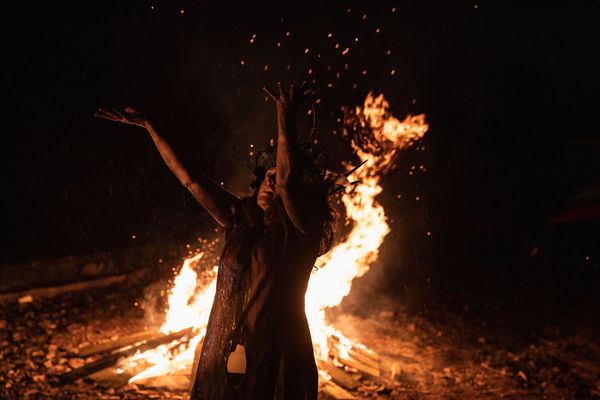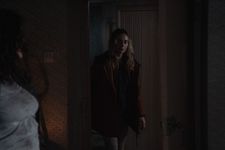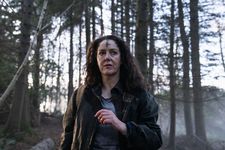 |
| Derbhle Crotty as 'Bloody' Mary Laidlaw in Mandrake Photo: courtesy of Glasgow Film Festival |
The darkly atmospheric tale of probation officer Cathy Madden (Dierdre Mullins), who is tasked with overseeing the rehabilitation of murderer ‘Bloody’ Mary Laidlaw (Derbhle Crotty) in a small Irish village but quickly finds herself out of her depth, Mandrake is part of the Frightfest selection at this year’s Glasgow Film Festival. It’s the début feature for director Lynne Davison, who has previously focused on shorts, so when she and I got the chance to chat, I began by asking her why she chose this time and this project to transition to a longer format.
“I really feel that short film is a wonderful genre unto itself,” she says, “and I think standalone stories are brilliant. But I had longer stories that I wanted to tell. It's a very hard stage of filmmaking, because it's hard to get the the funds to do a lot of this, begging and borrowing. And, you know, I worked as a camera assistant, so I knew a lot of people that would help me and lend me equipment and whatnot. But there's only so many times that you can ask somebody to do that for you.
“My last short film did very well. I signed with an agent after that, and I got a BBC job, and I just started to do longer form content. And I just loved it. The goal has always been to direct feature films, and series now, because series obviously have taken on a new life. But I was always so inspired when I was little, watching films that I probably shouldn't have been watching. It was always the dream that that was what I was going to do. And I've so many stories I've written, and I've read, and I want to tell, and it's the best way to do it.”
This script was written by Matt Harvey, so was she involved in developing it or did she come to it when it was fully formed?
“I actually just came to the script. So I was living in England for a little bit, and then I moved back to Northern Ireland. And because I had cultivated this great relationship with Northern Ireland Screen, I contacted the development executive there and asked her if she had anything that she thought I might be interested in, and she had Mandrake. So she connected the writer and I, and I read it, and we met up. And we basically both wanted to make the same film, which is wonderful and rare. And then I contacted the producer, a friend of mine who I always wanted to work with, but we hadn't had the opportunity. And then after a couple of weeks, I called him back and he had optioned the script.
“It all happened very quickly and fluidly. But, you know, you have to preface that with there was about 15 years of networking and building relationships. So yeah, I'm very thankful that it worked so smoothly for me. And then of course, Northern Ireland Screen have their New Talent Focus, which a lot of my fellow filmmakers and I, everybody applies every year, and we always talk about who's going to get it this year. So I'm very fortunate that for want of a better phrase, it was my turn.”
 |
| Deirdre Mullins in Mandrake Photo: courtesy of Glasgow Film Festival |
She’s done a lot of films in the past focused on strong female characters, and Mary is a fascinating character because she's such a complex individual. On the one hand, she could be seen as a monster, but she's also a woman who has empowered herself.
“I always feel that the best villains have a degree of humanity, their own code, their own reasoning for what they're doing,” she says. “That was something I really wanted to bring to her. I didn't want my film to be a standard horror with good guys and with bad guys. I wanted a little bit of grey in there, where, you know, morals can be challenged. And I did want the audience to feel for her and feel sorry for her but obviously that doesn't justify what she does. But just to pull at the heartstrings of our humanity for each other. I think it's a really interesting thing to do, and I love when I see it in other things. I just wanted so desperately for her not to be this moustache-twisting villain.
“Derbhle and I talked about it quite a lot and we wanted to understand her, we wanted to know who she was and why she did these things. Her magic comes from what she can exploit from nature and how intrinsic nature is to her and how she brings it into her home. And fundamentally, the wild in nature is cruel and relentless and it does what it wants. We always wanted to bring that in with her, with regards to particularly awful thing that happens in the film. You can tell that she doesn't really want to do it, but she knows she has to.”
There’s wonderful photography from the very start exploring the landscape as we go into that small village and see the twisted branches of the woodland surrounding it. There's obviously been work done in folk horror before to bring those landscapes to life, so how did she make that imagery her own?
“I worked so closely with my cinematographer, Conor Rotherham. Conor and I really wanted to bring all of the harsh elements of nature into it and have that wildness and that unforgiving nature. We wanted to work with a lot of cold colours, cool blues and greens, and angles that were a little bit old. Maybe some of the ones that are my favourites are when we just look up at the tree line. Because we were so pressed for time, we worked out exactly what we wanted to do with everything prior to shooting. We had drawn very coarse storyboards ourselves before we even had a storyboard artist, and and then when we were shooting, because we were limited for time – we had 18 days – in between scenes, I would make sure that Conor would just turn the camera around and maybe catch something that we could use to build our atmosphere.
“Pace is just so vital to me in every film that I do, you know, and in my favourite films. Alien is about pace, it's about that steady build, it's about understanding that this is isolation and, you know, the dynamics of people trying to work together in a crumbling ship? And that's what I really wanted to do.”
The location is a really strong setting in itself, especially with the house where Mary lives. How did she find that?
“Oh, my goodness, we had such trouble finding that house,” she says. “We actually started to look on Property Pal, just to see what houses were for sale. We thought maybe we might find something there, we might get a good idea of what was around it. And myself and my producer both separately found this house, and then we had to go and talk to the people that owned it. And even just from their stories, the house had such an air about it. I'll never forget that there was this one long corridor room, and it had a door at the end of it, and it was the spookiest room that I’ve ever seen. And I remember, the owner of the house said that she remembered locking her grandmother in that room when she was a child. I think after hearing that story, I was sold. I was like, well, ‘We need to. We need to shoot here.” The place just has such a tone and a weight to it, of its own. And obviously bringing nature elements into it really helped. And it was so cold. I mean, it was very cold for us, in actuality. I wanted it to feel cold. And nobody is welcome in that house.
 |
| Derbhle Crotty in Mandrake |
“My production designer, Vanessa O'Connor did a wonderful job of just collecting things, and when I walked into the house, and she had first set it up, it was overwhelming, especially the antlers over the fireplace.”
A lot of work has clearly gone into researching the magical traditions we see used in the film. I note that there are a number of elements there which I’ve read about before.
“We really wanted to keep it based in reality, and I know that might sound a bit crazy to some people, but we wanted it to be based on things that people already know,” she says. “I'm really delighted that you recognise some stuff. We had pagan elements in there, we had Wicca elements in there, Ancient Irish. I specifically love the Ancient Irish elements that we were able to bring into it. There's an ancient language that we've brought into it with the symbol on Mary's forehead. It’s a little signature of where we're from and what we're doing. But the basis in reality, you know, I didn't want it to be fantastical. And not that I'm bad mouthing this film at all, but the new Craft film, the magic in it was all sparkles – which probably is the magic of teenage girls, to be honest – but I wanted my magic to be gritty, like the earth, soil and blood. And I think we achieved that because we did look at what people thought was magic, what people think is magic.”
Of course, one of the elements in that tradition is that mandrake has to be harvested at night, but when you're on a small budget, how do you approach those nighttime scenes?
“There was much deliberation and much planning. And I think my cinematographer in particular was pulling his hair out!” She laughs. “Thankfully, we found our perfect tree, and there was an access road right beside it, so we could have access and put our lights up and everything. And I honestly think that the day that my leading lady Deirdre dug the mandrake out of the ground was the worst day of her life. Hopefully I'm wrong. But, you know, night shoots are part of the joy of filmmaking to me, I remember working on a horror film in 2008 where it was all night shoots, and that's what film crews are built for, you know? We want a little bit of punishment. Anything to get a great shot.”
So how did she cast those two central roles?
“It was very hard to find my Cathy and my Mary. We had a long process. Georgia Simpson, who's our casting director, she really looked under every rock to find the right people. And it didn't really feel like it was coming together until Deidre and Derbhle read. And it was like, they embodied the characters. There's this wonderfully cosmic moment where you just see the character in the performance. I love giving actors the opportunity to express themselves and to tell me what they want to achieve in the scene, and because we aligned on who we thought the characters were and what we thought the story was, that meant that I could have so much freedom to utilise the talent of my actors. And I think it worked wonderfully.”
So finally, how does she feel about the film being at Frightfest?
“Oh, absolutely delighted,” she beams. “I mean, any excuse to go back to Scotland is always high on my agenda. I spent a lot of my twenties in Scotland. But I'm just delighted. It's such a wonderful platform to have my home première, and the festival have just been amazing to me so far. It’s going to be a fantastic experience. And there are a few other films from home that are actually there as well. We'll have a little bit of celebration for that, I'm sure.”
One of the films she’s looking forward to is Kate Dolan’s You Are Not My Mother, and she’s unlikely to be disappointed. This year’s Glasgow Frightfest has a strong line-up, but these two Irish contributions still stand out.
Mandrake screens at the Glasgow Film Theatre at 10:45am on 12 March.





















